Leafhopper Fauna Associated With Groundnut Crop Ecosystem In Rayalaseema Region of Chittoor District in Andhra Pradesh
0 Views
K. SHAMILI DHATRI*, M.S.V. CHALAM, A. RAJESH, B. RAMANA MURTHY AND
N.C. VENKATESWARLU
Department of Entomology, S.V. Agricultural College, ANGRAU, Tirupati.
ABSTRACT
Nine leafhopper species were collected, identified and described from groundnut crop ecosystem in Rayalaseema region of Chittoor district of Andhra Pradesh. The leafhopper fauna collected from grounndut includes, Exitianus indicus (Distant), Cofona spectra (Distant), Empoasca kerri (Pruthi), Empoasca motti (Pruthi) and Empoasca spirosa (Dworakowska), Empoascanara indica (Dworakowska), Bactracomorphus angustatus (Osborn), Balclutha incisa (Matsummura) and Balclutha saltuella (Kirschbaum). An illustrated key along with diagnostic taxonomic characters were provided for easy identification of the leafhoppers associated with groundnut crop eco-systems.
KEYWORDS:
Leafhoppers, Groundnut
INTRODUCTION
Leafhoppers, an economically important group of Auchenorrynchan Hemiptera belong to the family Cicadellidae comprising about 2,445 described genera and 22,637 species in the world and 340 genera and 1,350 species in India (Viraktamath, 2006). Leafhoppers are small wedge shaped insects of various forms, colours, sizes and can be readily distinguished from other members of Auchenorryncha by having one or more rows of small spines extending the length of hind tibia. Viraktamath (2006) carried out taxonomic studies on the economically important leafhoppers of the Indian subcontinent under the Emeritus Scientist Project financed by the Indian Council of Agricultural Research, in which he has provided the keys to subfamilies, tribes and genera and also the checklist of leafhoppers of Indian subcontinent with colour photographs for more than 198 species of leafhoppers. Leafhoppers besides causing yield loss through direct feeding activity, also act as vectors of important viral diseases that cause fatal disease and death of plants. In Andhra Pradesh, groundnut is grown in an area of 735 million hectares with a total production of 1048.41 million tonnes and productivity of 1426 kg ha-1 (Anonymous, 2018a). In Chittoor district, groundnut is grown in an area of 1.29 lakh hectares, with a total production 10.5 lakh tonnes and productivity of 1426 kg ha-1 (Anonymous, 2018b). Amongst sucking pests, leafhoppers were reported to cause a serious damage incurring losses up to 22 per cent throughout the crop growth period. The knowledge on accurate identification and biology of a pest allows formulating the management strategies effectively. This article describes the taxonomy of leafhopper fauna associated with groundnut crop in Chittoor district.
MATERIAL AND METHODS
Intensive surveys were conducted and large number of leafhopper specimens were collected from ten mandals of Chittoor district in Andhra Pradesh. About 10-15 to and fro net sweepings were taken each time and leafhoppers collected were aspirated from the net into a glass tube and killed with a cotton swab wetted with a few drops of ethyl acetate. The killed specimens were transferred to homeopathic vials, labelled, brought to the laboratory and dried in a hot air oven at 45-50 0C, for about 5 to 6 hours. For mounting and preparing slides of genitalia the procedure suggested by Knight (1965) was followed. For describing the different body parts the terminology suggested by O’Brien and Wilson (1985) was followed.
RESULTS AND DISCUSSION
During the present studies, from groundnut crop ecosystems of Rayalaseema region of Chittoor district, the following leafhopper fauna were collected, identified and described to facilitate easy identification by economic entomologists.
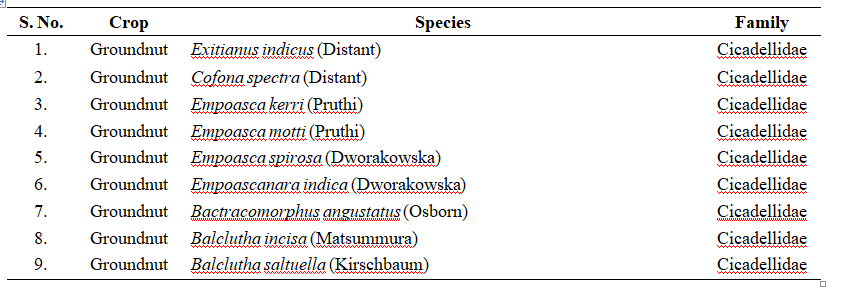
The most brief and important taxonomic and morphological characters of the above keyed species were provided here under for confirmation of identifications.
Exitianus indicus (Distant) (Fig. 1a-1d and Plate 1A): Head as wide as pronotum. Vertex moderately acute with a median coronal suture. Ocelli located on anterior margin of the vertex away from the eyes by their own diameter. Clypellus slightly narrower towards vertex and extended upto the margins of genae. Pronotum wider than long. Forewings elongate, subhyaline with four apical and three anteapical cells and appendix wider. Aedeagus simple, curved having an articulation between shaft and base, apex notched. Gonopore large and subapical.
Cofona spectra (Distant) (Fig. 2a, 2b and Plate 1B): Head wider than pronotum. Vertex shorter than pronotum with distinct ocelli on the basal portion of vertex. Clypeaus and clypellus are swollen. Forewings subhyaline with four apical and three ante-apical cells and appendix present. Sternal abdominal apodemes present. Aedeagus is ‘C’ shaped with the caudal end bifurcated in lateral view.
Empoasca kerri (Pruthi) (Fig. 3a-3d and Plate 1C): Head as wide as pronotum. Vertex subacute and coronal suture not conspicuous; ocelli present on the anterior margin of vertex close to the eyes; clypellus parallel sided, extending beyond the margins of genae. Pronotum wider than its length. Forewings subhyaline with four apical cells, ante- apical cells and appendix absent; hindwings hyaline. Abdominal apodemes well developed, elongated and tube like. Aedeagus tubular, notched and broader apically and gradually narrowed towards the proximal end.
Empoasca motti (Pruthi) (Fig. 4a-4d and Plate 1D):
Head slightly broader than the pronotum. Vertex subacute and coronal suture indistinct. Ocelli distinct and situated on the outer margin of the vertex, which are away from the compound eyes. Forewings subhyaline with four apical cells, anteapical cells and appendix absent. Aedeagus is tubular, bulbous in middle and apex is broadened.
Empoasca spirosa (Dworakowska and Viraktamath) (Fig. 5a-5e and Plate 1E): Head slightly wider than pronotum. Vertex subacute with distinct coronal suture. Ocelli conspicuous and close to the eyes. Forewings light green colour with four apical cells, anteapical cells and appendix absent; hindwings hyaline. Abdominal apodemes well developed. Aedeagus tubular, broad in the middle and apex rod like.
Empoascanara indica (Datta) (Fig. 6a-6f and Plate 1F): Head as wide as or slightly broader than pronotum. Vertex subacute, smaller than its width between the eyes, median sulcus seen clearly. Ocelli present on face away from the eyes. Clypellus wider at base and gradually narrowed to apex, extending to margins of genae. Forewings subhyaline with four apical cells. Anteapical cells and appendix are absent. Hind wings hyaline with two apical cells. Aedeagus with its shaft simple, tubular, without any processes, broader at base, abruptly narrowed towards apex and gonopore subapical.
Bactracomorphus angustatus (Osborn) (Fig. 7a-7c and Plate 1G): Head narrower than the pronotum. Vertex short, transversely rugose and anterior margin broadly rounded in dorsal aspect. Ocelli large, located on the anterior margin of face away from the eyes, twice their own diameter. Clypellus distinctly short and parallel sided. Pronotum transversely rugose and lateral margins carinate. Forewings subhyaline with four apical and three ante-apical cells. Appendix well developed. Aedeagus loosely articulated with connective. The tip of aedeagus is clefted with two finger like projections which are widely separated.
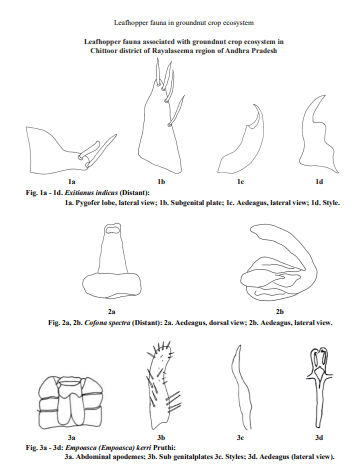
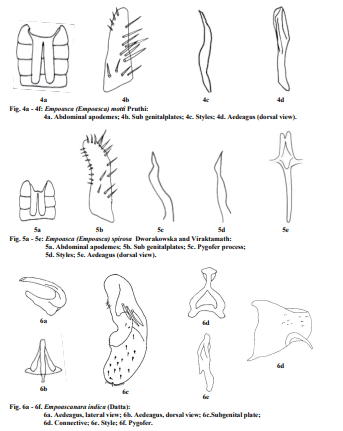
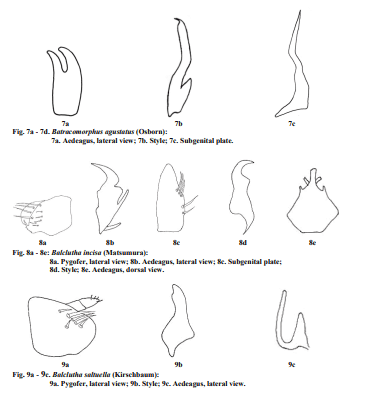
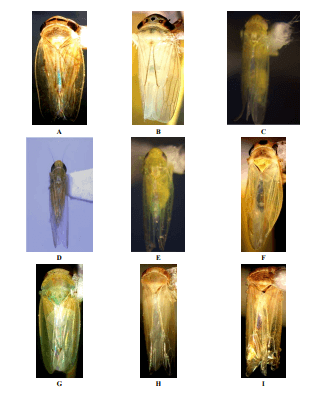
Balclutha incisa (Matsummura) (Fig. 8a-8e and Plate 1H): Head more or less as wide as pronotum. Vertex is of uniform length, much shorter than pronotum. Ocelli present on anterior margin of vertex and visible dorsally. Forewings long and slender with wider appendix and with four apical cells and only two ante-apical cells, inner one opens basally. Aedeagus broad basally with 3 pairs of processes, shaft slender directed posteriorly and curved anteriorly; gonopore apical.
Balclutha saltuella (Kirschbaum) (Fig. 9a-9c and Plate 1I): Head wider than pronotum. Vertex rounded. Ocelli located on anterior margin of vertex near to the eyes. Scutellum shorter than pronotum. Pronotum shorter in length than width, plain and glabrous. Forewings long, slender, hyaline to subhyaline, appendix wider. Forewings are with three apical and two anteapical cells. Aedeagus elongate simple, shaft narrow; gonopore apical.
Young (1979) reviewed genus Cofana thoroughly and described seven species. Sohi and Dworakowska (1983) described 22 species in the genus Empoasca nara. Mathew and Ramakrishnan (1995) reported the occurrence of E. (E.) kerri in groundnut from Kerala. In 1995, Mathew and Ramakrishnan recorded E. (E.) motti on colocasia and cowpea. Jacob et al. (2000) reported E. indicus on groundnut from Andhra Pradesh. Jacob et al. (2002) reported the occurrence of B. incisa on greengram, blackgram and pigeon pea and B. saltuella on greengram, blackgram, pigeon pea, chickpea, soyabean and cowpea from Andhra Pradesh. Kandakoor (2011) reported the occurrence of B. angustatus on groundnut. Bhandhavi (2010) studied E. (E.) kerri and E. (E.) spirosa associated with vegetable crop ecosystems in Rayalaseema area. Nagesh (2018) collected, identified and described B. angustatus on fingermillet and maize in Rayalaseema region. In the present studies nine leafhopper species belonging to family Cicadellidae from groundnut crop eco systems were collected, identified, described and illustrated for easy and quick identification. Illustrations were also provided which will be useful aid to identify the leafhoppers by research and extension workers. The accurate identification of leafhopper fauna associated with a particular agro-ecosystem is very much needed to formulate integrated management strategies whenever they attain pest status.
LITERATURE CITED
Bhandhavi, C.S. 2010. Taxonomic studies on leafhopper fauna associated with vegetable crop ecosystems in Rayalseema area. M.Sc. (Ag.) Thesis. Acharya N. G. Ranga Agricultural University, Department of Entomology, S.V. Agricultural College, Tirupati.
Anonymous. 2018a. Ministry of Agriculture Government of India. 2018. www.indiastat.com.
Anonymous. 2018b. Directorate of Economics and Statistics. http://desap.cgg.gov.in.
Ghewande, M.P. 1987. Virus diseases of groundnut and their management. In: Symposium on Diseases of Oilseed and Pulse Crops and their Control. (eds. Vyas, S.C.C and Sgroff, V.N.). Jawaharlal Nehru Krishi Vishwa Vidyalaya, Indore.
Jacob, P.S., Ramasubbarao, V and Punnaiah, K.C. 2000. Leafhopper fauna associated with oilseed crops in Andhra Pradesh, India. Pest Management and Economic Zoology. 8(1): 11-27.
Jacob, P.S., Ramasubbarao, V and Punnaiah, K.C. 2002. New record of leafhoppers (Cicadellidae: Homoptera) associated with pulse crop-ecosystems in Andhra Pradesh. The Andhra Agricultural Journal. 49(3-4): 256-261.
Kandakoor, B.K. 2011. Studies on sucking insect pests of groundnut (Arachis hypogaea L.) and their management. M.Sc. (Ag.) Thesis. University of Agricultural Sciences, Bangalore.
Knight, W.J. 1965. Techniques for use in the identification of leafhoppers (Homoptera: Cicadellidae). Entomologist’s Gazette. 16: 129-136.
Mathew, M.P and Ramakrishnan, U. 1995. Typhlocybinae of Kerala, India (Cicadellinae: Empoascini). Shashpa. 2 (1): 1-11.
Nagesh, S. 2018. Taxonomic studies on leafhopper fauna associated with graminaceous cropecosystems in Rayalaseema region of Andhra Pradesh. M. Sc., thesis. Acharya N. G. Ranga Agricultural University, Department of Entomology, S.V. Agricultural College, Tirupati.
O’Brien, L.B and Wilson, S.W 1985. Planthopper systematics and external morphology. In, Nault, L.R and Rodriguez, J.G. (eds.). The Leafhoppers and Planthoppers. John Wiley and sons, New York 61-102.
Sohi, A.S and Dworakowska, I. 1983. A review of the Indian Typhlocybinae (Homoptera: Cicadellidae) from India. Oriental Insects. 17: 159-213.
Viraktamath, C.A. 2006. Final report of emeritus scientist project on taxonomic studies on the economically important leafhoppers (Hemiptera: Cicadellidae) of the Indian subcontinent. Department of Entomology, University of Agricultural Sciences, GKVK, Bangalore. 65-70.
Young, D.A. 1979. A review of the leafhopper genus Cofana. Proceedings of the Entomological society of Washington. 81: 1-21.
- Genetic Divergence Studies for Yield and Its Component Traits in Groundnut (Arachis Hypogaea L.)
- Correlation and Path Coefficient Analysis Among Early Clones Of Sugarcane (Saccharum Spp.)
- Character Association and Path Coefficient Analysis in Tomato (Solanum Lycopersicum L.)
- Survey on the Incidence of Sesame Leafhopper and Phyllody in Major Growing Districts of Southern Zone of Andhra Pradesh, India
- Effect of Organic Manures, Chemical and Biofertilizers on Potassium Use Efficiency in Groundnut
- A Study on Growth Pattern of Red Chilli in India and Andhra Pradesh

